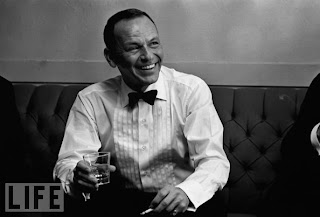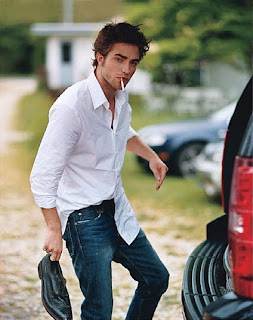
Frank Sinatra at a Capitol Records recording session, circa 1959 for "Come Dance with Me"

"The first commercial radio station, for example, was established in 1920; by 1922 there were 508, and by the end of the decade Americans were spending $850 million a year on radio equipment. Until around the time Sinatra was born, the United States was predominately a culture of production: its social values, material conditions and economic realities (like relatively high labor costs, which fostered technological innovation as well as the immigration of intellectual capital from abroad), helped create a society in which making things was paramount.

Starting in the 1920s the U.S. became a culture of consumption: the future success of capitalism depended on nation’s ability to absorb incredible productive capacity via buying, spending, using up. Indeed, it was precisely the difficulty in absorbing this capacity that was widely blamed for the advent of the Great Depression. This new culture of consumption had important psychological ramifications that reached deep into the roots of mass consciousness. In the words of cultural historian Warren Susman, a society that once placed emphasis on character now prized personality. “Character” has a moral connotation; it suggests the essential nature of an individual in a way that transcends surface appearances. But “personality” suggests the allure of precisely such surface.

Frank Sinatra worked extremely hard. That ambition emerged from the mists of his childhood shortly after the Crosby concert in 1935, when Sinatra made his first serious effort to break into show business by trying out for the Major Bowes and his Original Amateur Hour, a nationally broadcast radio show. (“Round and round she goes” went Bowes’s signature saying, referring to the wheel of fortune, “and where she stops nobody knows.”) It’s not clear whether it was Bowes’ inspiration or Dolly’s machinations that led him to join another auditioning group, The Three Flashes, which was rechristened The Hoboken Four. Sinatra stayed on until the bullying of other group members led him to quit at the end of the year.

When Sinatra entered Columbia Recording Studios on March 27, 1951, his career had just about bottomed out. The label hadn’t dropped him yet, but the writing was on the wall. This was the period in his life when he was producing his most embarrassing work – a time when, in collaboration with Columbia executive Mitch Miller, he recorded novelty songs like “The Huckle Buck” and “Mamma Will Bark” that generated ridicule perhaps most vociferously from Sinatra himself. Confident yet melancholy, clearly patterned on the blues and yet bearing the stamp of his own inimitable style, “The Birth of the Blues” almost single‐handedly illustrates the difference between Sinatra’s commercial decline and artistic decline.

Sinatra was reputedly miserable. His wife Nancy was refusing to give him a divorce, and a notably unsympathetic Gardner, who had a weakness for Spanish bullfighters, was making it clear to Sinatra that she would not wait indefinitely to get married. Interestingly, the song scheduled for the evening’s session was one – the only one, in fact – for which Sinatra claimed a songwriting credit. It was called “I’m a Fool to Want You.”

"L'amour se mesure à ce que l'on accepte de lui sacrifier." -Ava Gardner (Mémoires)
To borrow a term of psychoanalysts, the tone of “I’m a Fool to Want You” was “overdetermined” before he ever sang a note. Arranger Alex Stordahl opened the song with dark, almost weeping strings, a mood augmented by haunting backup vocals. When Sinatra himself enters, the emotion escalates even as the arrangement recedes; the intensity he brings to the words takes the feeling beyond heartsickness into bona fide grief. The death in question is not that of a relationship, but rather the self‐respect of a man who hates himself for what he has become. Mere words can’t express this loathing: you have to hear it to believe it. Although a composer and lyricist also worked on the song (and probably were the primary writers), it seems unusually apropos for Sinatra to receive songwriting credit for “Fool”: his contribution to it is utterly unmistakable.

One of the more remarkable aspects of “Fool” is that it does not simply capture a powerful inner experience. It also charts a trajectory of emotion from resistance to capitulation. At first, the singer acknowledges that indulging in his longing is counterproductive. But by the bridge of the song, there’s a slippage between past and present, and it becomes increasingly clear that its lovelorn protagonist has not gotten over the relationship. “Pity me: I need you.” Never before and never again would Sinatra sing with the tremulous intensity that he sings these words – especially “need” – and the song ends with an assertion that his man simply can’t carry on without his lost love.

It has been customary in (mostly brief) discussions of “I’m a Fool to Want You” to emphasize the obvious autobiographical dimensions of the song – as indeed I’ve done here. But such an approach, however valid and useful, also has the effect of obscuring the nature of Sinatra’s achievement. The really striking thing about “Fool” is not that Sinatra was able to spontaneously express his pain in song (this underestimates the decades of applied passion and discipline that Sinatra brought to the studio that night). Nor is it that “Fool” is an especially intelligent or insightful piece of music (considered solely on the basis of lyrics or music in isolation, it would undoubtedly seem both melodramatic and trite).

Here’s what’s really great about the song – and, by extension, much of Sinatra’s best music: a kind of emotional honesty that closes a gap between people. The protagonist of “Fool” has no lesson or advice to offer; indeed, the unresolved ending is part of what makes it so harrowing. And yet for reasons that aren’t entirely clear, a powerfully rendered rendition of an inner life, even an anguished one, can bring comfort to those with whom it is shared: You are not alone. You are not alone in your feeling of deprivation, and perhaps more importantly, you are not alone in feeling foolish for wanting things you had no real right to expect, but could not help but want anyway.

In short, Sinatra’s performance in “I’m a Fool to Want You” is a profoundly creative act, one that falls more into the realm of character than personality. -"American History for Cynical Beginners, Chapter Six - Mr. Sinatra Gets Rejected" By Jim Cullen
 "Drink, drink, drink. Smoke, smoke, smoke. Shmuck, shmuck, shmuck!" —Frank Sinatra, chastising himself for the excesses that made his voice raspy during the taping of a '60s TV special. Pictured: In 1964, Frank savors those vices backstage at the Sands Hotel and Casino, where he swung with the Count Basie Band. Out of that landmark collaboration came the legendary live album Sinatra at the Sands.
"Drink, drink, drink. Smoke, smoke, smoke. Shmuck, shmuck, shmuck!" —Frank Sinatra, chastising himself for the excesses that made his voice raspy during the taping of a '60s TV special. Pictured: In 1964, Frank savors those vices backstage at the Sands Hotel and Casino, where he swung with the Count Basie Band. Out of that landmark collaboration came the legendary live album Sinatra at the Sands. Anthony Summers, author of "Frank Sinatra: My life" (2006): "One of the strange anomalies is that a man, who not only drank so much but smoked so much - those untipped Camel cigarettes - for years and years and years, was still able to put out such a wonderful voice over such a long period. We learned that he went off the booze and off the cigarettes for a period before he made an album".
Anthony Summers, author of "Frank Sinatra: My life" (2006): "One of the strange anomalies is that a man, who not only drank so much but smoked so much - those untipped Camel cigarettes - for years and years and years, was still able to put out such a wonderful voice over such a long period. We learned that he went off the booze and off the cigarettes for a period before he made an album". Frank Sinatra lights a cigarette for Natalie Wood
Frank Sinatra lights a cigarette for Natalie Wood Dean Martin and Frank Sinatra photographed in a recording studio by LIFE's Allan Grant, take a cigarette break during the recording of Sleep Warm in 1958. The album was re-released in 1963 with a much more direct title: Dean Martin Sings/Sinatra Conducts.
Dean Martin and Frank Sinatra photographed in a recording studio by LIFE's Allan Grant, take a cigarette break during the recording of Sleep Warm in 1958. The album was re-released in 1963 with a much more direct title: Dean Martin Sings/Sinatra Conducts. Frank Sinatra smoking a cigarette in the studio during a rehearsal in 1965.
Frank Sinatra smoking a cigarette in the studio during a rehearsal in 1965. "He wears the mask of an armchair philanderer with bottles and broads on his mind and seven kids in his swimming pool — a character with obvious appeal for both sexes. Highball glass in hand, he always looks faintly surprised to find the camera upon him, and his first bleary, self-deprecating crack establishes that neither he nor his audience can be quite sure what he will do next." —From LIFE's review of The Dean Martin Show, 5/26/1967. Photographed by LIFE's Allan Grant, Dean Martin is smoking and adjusting his cufflinks backstage before a performance in Vegas, 1958.
"He wears the mask of an armchair philanderer with bottles and broads on his mind and seven kids in his swimming pool — a character with obvious appeal for both sexes. Highball glass in hand, he always looks faintly surprised to find the camera upon him, and his first bleary, self-deprecating crack establishes that neither he nor his audience can be quite sure what he will do next." —From LIFE's review of The Dean Martin Show, 5/26/1967. Photographed by LIFE's Allan Grant, Dean Martin is smoking and adjusting his cufflinks backstage before a performance in Vegas, 1958. Lindsay Lohan
Lindsay Lohan Ava Gardner
Ava Gardner Diane Lane
Diane Lane Paul Newman
Paul Newman Shia Labeouf
Shia Labeouf Monica Bellucci
Monica Bellucci Ida Lupino
Ida Lupino Ryan Gosling
Ryan Gosling James MacAvoy
James MacAvoy Humphrey Bogart
Humphrey Bogart Kevin Spacey
Kevin Spacey Robert Pattinson
Robert Pattinson





























































